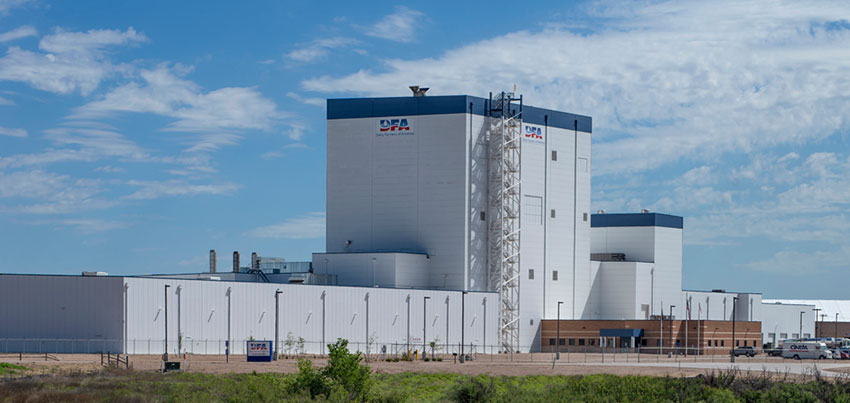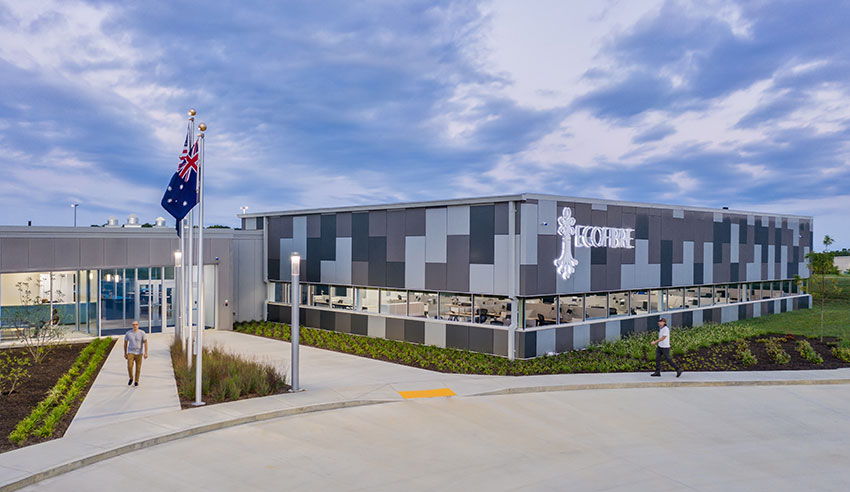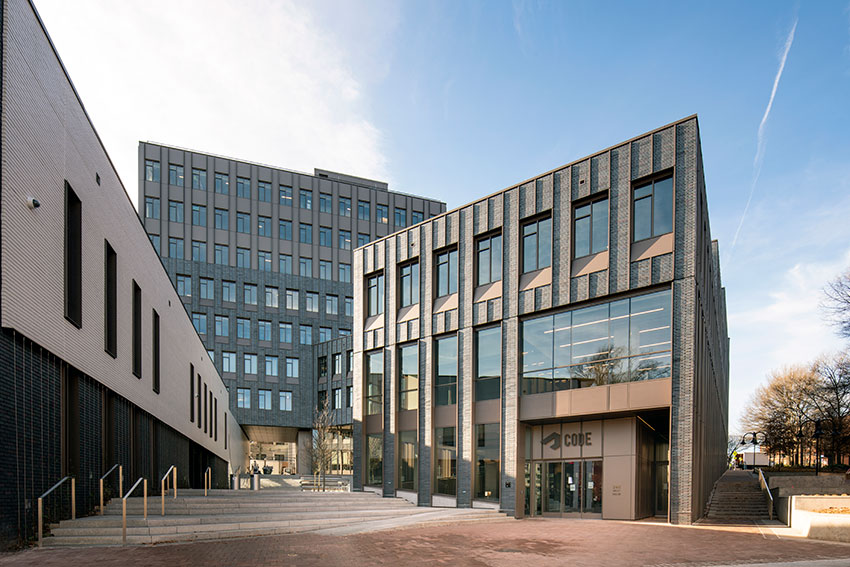This course is part of the Metal Architecture Academy
Architects and design professionals need to face future choices right now in designing for a better built environment. The buildings of today must satisfy a supreme standard: they are called upon to achieve functional performance and sustainability, to be resilient and promote occupant health, and to be energy efficient, all while minimizing consumption of materials and resources difficult to replace. As the building industry plays a significant role in fighting climate change, building envelope material selections that improve building performance and lower overall CO2e emissions are vital. These demands elicit dramatic changes to building envelope design and the components used within. They also require the data and tools necessary to enable broad and swift action across the building industry in addressing embodied carbon's role in climate change.

Photo courtesy of CetraRuddy Architecture, Esto/David Sundberg, and Rockefeller Group
The impact of embodied carbon will continue to grow in importance as a proportion of total structure emissions. Rose Hill, New York City.
Carbon And The Building Industry
Greenhouse gases (GHGs) are gases in our atmosphere which interact with sunlight in the infrared range in a way that increases their temperature. Most gases are transparent to infrared radiation but there are important exceptions such as carbon dioxide, or CO2. Global warming is the result of increasing levels of greenhouse gases in our atmosphere and has potentially devastating results.
There are many greenhouse gases, but CO2 is of primary concern because of its high potency and proliferation as a direct result of human activity. Consequently, all greenhouse gases are expressed in terms of their ability to impact Global Warming relative to that of 1 kg of CO2. Collectively, these gases are termedCO2 equivalents, abbreviated as CO2e. The difference between GHG and CO2e is that different gases are weighted by potency in CO2e, whereas GHG is an unweighted generalized term. CO2e emissions are often called “carbon” for short, although that is a misnomer. Strictly speaking, carbon is an element and is a solid at earthbound temperature and pressure ranges.
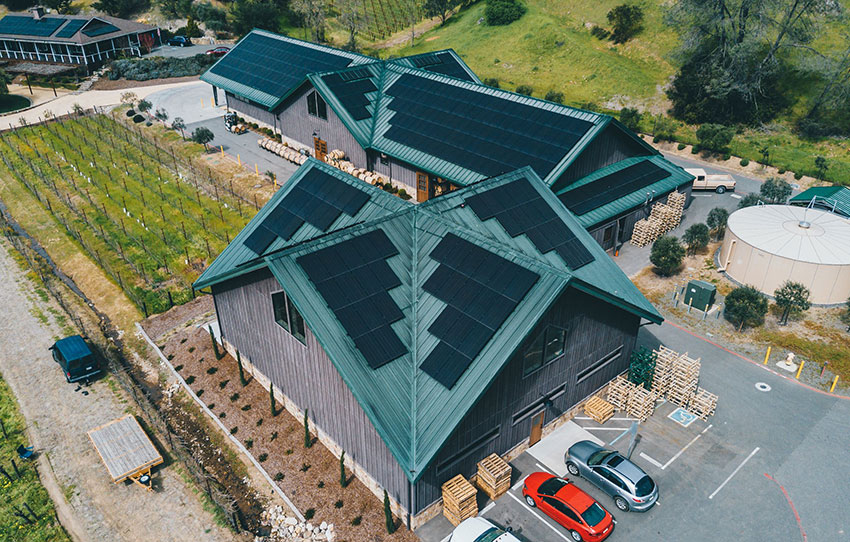
Photo courtesy of All Weather Insulated Metal Panels
As the operational carbon footprint of a building is reduced, thCO2e emissions associated with the structure’s materials during their life cycle, called embodied carbon, grow in importance as a proportion of total structure emissions. Caligstoga, Calif.’s Venge Winery with insulated metal panel roof.
Defining Embodied and Operational Carbon
CO2e emissions occur not only throughout a structure’s operational life but also during the manufacturing, transportation, construction, and end-of-life phases of all built assets – buildings and infrastructure. CO2e emissions associated with material creation, the transportation, construction and deconstruction, and final transportation and material disposal of a building or infrastructure element are all categorized as embodied carbon. This is different from Operational carbon, which are all CO2e emissions stemming from the operation and use of the building or infrastructure element during its lifetime. Operational carbon is mostly due to energy consumption and on-site fuel combustion and is not addressed in this course. However, it is important to understand that both contribute to global warming, and it is the reduction of total CO2e that is important. Trading embodied carbon for operational carbon 1:1 has no net impact.
Embodied carbon, which has largely been overlooked historically, contributes around 11% of all global carbon emissions, according to the World Green Building Council. Architecture 2030 states that the building sector accounts for 39% of global greenhouse gas (GHG) emissions—28% of which is from building operations, while the remaining 11% is specifically from building materials and construction.
While energy use associated with building operations can be reduced over time with measures such as energy efficiency retrofits, shifts towards renewable energy procurement, and on-site renewable energy installations, embodied carbon from building materials and construction are unchangeable once a building is completed, with a possible exception of some unforeseeable reductions associated with end-of-life processes. As the operational carbon footprint of a building is reduced, embodied carbon will continue to grow in importance as a proportion of total structure emissions. CO2e emissions occurring released before the building or infrastructure begins to be used, sometimes called upfront carbon, will be responsible for half of the entire carbon footprint of new construction between now and 2050, according to the World Green Building Council, threatening to consume a large part of the remaining carbon budget set by the Paris Agreement.
The 11% of GHG accounted for by building materials and construction represents a fixed carbon cost as the embodied carbon is essentially locked into buildings once they are built. The "locked-in" nature of embodied carbon means that the opportunity for architects and building owners to reduce the total carbon footprint of a building, as it relates to building materials, must occur during the design and procurement phases of a project. This clearly underscores the critical importance of thoughtful material selection and detailed specifications at the outset.

Photo courtesy of Jason O’Rear Photography; courtesy of CENTRIA
The products we choose have impacts. An EPD tells the life-cycle story of a product in a single, written report, focusing on information about a product’s environmental impacts, such as global warming potential (GWP), smog creation, ozone depletion potential (ODP), use of limited resources, and water pollution. Chase Center, San Francisco.
The Decade of Getting to Net Zero
Buildings can play a central role in reducing GHG impacts. Architecture 2030, a nonprofit organization dedicated to rapidly transforming the built environment from the major contributor of greenhouse gas emissions to a central solution to the climate crisis, first released a carbon action plan in 2006. The 2030 Challenge calls for all new buildings, developments, and major renovations to be carbon-neutral by 2030. Under the Challenge, all new buildings, developments, and major renovations are designed to meet a fossil fuel, GHG-emitting, energy consumption performance standard of 70% below the regional or national average for that building type. For embodied carbon actions, achieving zero embodied emissions by 2040, the goal presented in the Challenge, will require adopting the principles of reuse, reduce, and sequester. Reuse includes renovating existing buildings when possible, using recycled materials, and designing for deconstruction. Reduce encompasses material optimization and the specification of low to zero carbon materials. Finally, sequester includes the design of carbon sequestering sites and the use of carbon sequestering materials, where doing so is feasible for function and maintenance of public safety standards.
To support the 2030 Challenge, the American Institute of Architects (AIA) created the 2030 Commitment Program, aimed at transforming the practice of architecture to respond to the climate crisis in a way that is holistic, firm-wide, project-based, and data-driven. Over 400 A/E/P firms have adopted the 2030 Commitment, and firms from all over the country have been tracking and reporting projects since 2010, with over 2.7 billion ft2 of project work reported in 2016 alone.
Likewise, the Structural Engineering Institute issued the SE2050 Commitment in 2019, prioritizing the reduction of embodied carbon through the use of less impactful structural materials to achieve a goal of net zero embodied carbon structural systems by 2050. Engineers and architects have a powerful role to play in determining the makeup of the built environment and its health. It is through embracing best practices of sustainable structural design and construction that we will realize the goal of net zero embodied carbon. Fortunately, tools, certifications, and programs exist to enable responsible material selection and establish appropriate embodied carbon reduction targets until net zero is realized.
Environmental Impacts And Material Selection
With the array of today’s analysis methods, selecting materials with confidence is possible. When endeavoring to select components and materials that reduce embodied carbon, knowing with certainty what is in each possible product becomes crucial.
Life-cycle assessment, or LCA, is a technique for assessing the environmental aspects associated with a product over its life cycle. The most important applications are an analysis of the contribution of the life-cycle stages to the overall environmental load, usually with the aim to prioritize improvements on products or processes; and a comparison between products for internal use.1 An LCA provides a description of material and energy flows within the product system and its interactions with the environment, the consumed raw materials, and emissions to the environment. A typical LCA methodology accounts for the environmental impacts associated with the inputs from and emissions to the environment that result from the manufacturing, maintenance, and disposal of products and materials found in the building.
An Environmental Product Declaration (EPD) is a comprehensive, internationally harmonized report that documents the ways in which a product, throughout its life cycle, affects the environment. An EPD tells the life-cycle story of a product in a single, written report, focusing on information about a product’s environmental impacts, such as global warming potential (GWP), smog creation, ozone depletion potential (ODP), use of limited resources, and water pollution. An EPD also can include other product impacts such as land use changes, potential toxicity risks, as well as voluntary environmental initiatives that are of particular interest to the discloser. A Type III Environmental Product Declaration is an EPD which adheres to specific format and impact reporting requirements set forth by an accredited standard and has been peer-reviewed.
EPDs do not rank products, and the existence of an EPD for a product does not indicate that environmental performance criteria have been met. EPDs are rather a disclosure tool that helps purchasers and design professionals to better understand a product’s sustainable qualities and environmental repercussions so that they can make more informed product selections. EPDs for most construction products will eventually be needed to demonstrate compliance.
Buy Clean initiatives, at both the state and federal level, are also becoming stronger drivers for products with lower embodied carbon emissions options and for EPDs in general. The Buy Clean California Act, enacted in October 2017, established embodied GHG emissions thresholds for select materials used in public buildings. The Buy Clean Colorado Act (July 2021), required EPDs beginning in July 2022. Other states considering Buy Clean legislation include Washington, Oregon, Texas, Minnesota, New York, and New Jersey. At the federal level, a Buy Clean Task Force is working toward the goal of a comprehensive federal Buy Clean program.
Under the Lens: Traditional and Alternative Building Products
The transition to a net-zero economy will be metal intensive.2 Steel is the only material critical to all low carbon technologies, including geothermal, hydro, nuclear, bio energy, electricity networks, and electric vehicles, making it essential to the U.S. decarbonization strategy, national and economic security, and critical infrastructure.
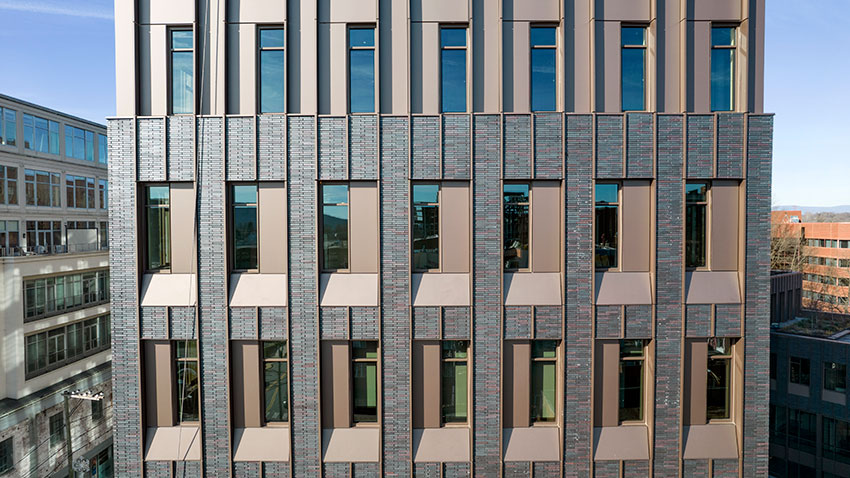
Photo courtesy of Kingspan Insulated Panels
With many green advantages over other materials, metal can reduce energy consumption, improve air quality and thermal comfort, help comply with energy codes, minimize environmental impacts, and get recycled indefinitely. The CODE Building, Charlottesville, Va.
Selecting to avoid embodied carbon means adhering to the principles of reuse, reduce, and sequester. While certain natural materials, like wood, may appear to have a more favorable CO2e profile, this can be misleading as all impacts, not just GWP, should be considered in responsible material selection. It is also important to consider the effect of service life on this analysis. A structure which lasts half as long as another actually should be considered as having twice the impact for comparison purposes. With many green advantages over other materials, metal can reduce energy consumption, improve air quality and thermal comfort, help comply with energy codes, minimize environmental impacts, and get recycled indefinitely. A key step to avoiding embodied carbon is reuse. Metal is the only known construction material that can be recycled indefinitely with little impact on material properties. This allows it to be repurposed in the same exact form, a process called closed-loop recycling. Not only are excess and scrap metals such as steel and aluminum readily and easily recyclable, it remains financially viable to do so. This ensures the envisioned impact reduction will actually happen, instead of only existing “on paper.” Sixty to 80 million tons of steel scrap is recycled each year into new steel products in the U.S. alone. This impacts the cradle to cradle profile of steel. First introduced in 2002 by architect William McDonough and chemist Michael Braungart, cradle to cradle refers to design standards for creating products that model a view of natural materials as nutrients, circulating in healthy, safe metabolisms. McDonough and Braungart present an integration of design and science in Cradle to Cradle: Remaking the Way We Make Things that provides enduring benefits for society from safe materials, water, and energy in circular economies and eliminates the concept of waste. Metal meets these requirements.
Shop-fabricated metal components reduce onsite labor, cycle time, and construction waste. A 2,000-square-foot residence framed in steel produces less than 2 percent leftover material, all of which can be recycled, compared to wood framing, which yields an estimated 20 percent waste going to a landfill. Metal cladding components are factory coated with a 20-40 year warranted life and any volatile compounds (VOCs) are controlled at the factory, not released at the jobsite. Daylighting and exterior views can also be easily incorporated into a metal building design to earn LEED credits using composite materials. Metal buildings offer effective insulation, reduced air leakage, and readily accept high-performance windows and doors. A metal roof can also be the ideal base to support solar panels. All of these factors can be used to earn LEED points.
Insulated metal panels (IMPs) are a type of “perfect wall,” due to the location of their control layers. Water, air, and vapor control layers are all located on the exterior of the structure, with thermal control located outboard of the other control layers. IMPs provide all four control layers within a single component, meaning they do not require the use of supplemental air/water/vapor or thermal control layers. Depending on climate zone and special requirements, IMPs can be used with supplemental cavity insulation subject to ratios listed in the International Building Code. Because of this construction, IMPs can be used in all climate zones: cold, mixed, hot, humid, dry, or marine. IMPs also work for the demands of all interior environments: office, commercial, residential, institutional, pools, museums, art galleries, and data processing centers.
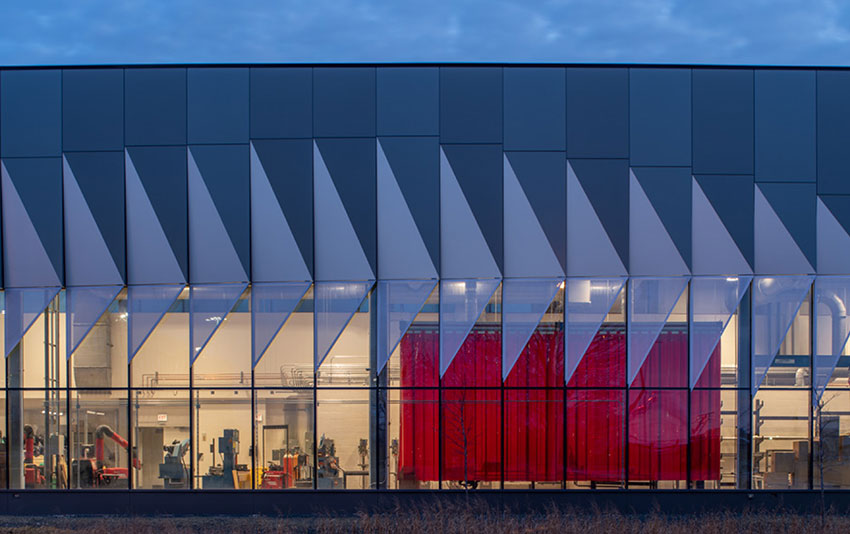
Photo courtesy of Tom Rossiter; courtesy of CENTRIA
IMPs are available in a wide variety of colors, widths, profiles, and finishes, enabling the realization of virtually any desired aesthetic for walls and roofs. Richard J. Daley College, Chicago.
IMPs can be used as a barrier wall system and can be integrated with other wall and roof systems while still maintaining proper control layer continuity.
The American steel industry leads the world in low embodied carbon emissions steel production. The industry continues to reduce its carbon profile in response to numerous drivers. Producing a ton of steel today in North America requires less than half the energy that was needed to produce a ton of steel 40 years ago, resulting in a 50 percent reduction in greenhouse gas (GHG) emissions. American steel production is the cleanest of the major steel-producing countries, with a cleaner electricity grid production than other regions. U.S. manufacturers have a significantly greater use of natural gas versus coal as an energy source and a larger share of electric arc furnaces (EAF). Integrated mills primarily use pelletized iron, not the lower quality sintered iron used in China and elsewhere. Purchasing U.S.-based steel has a much lower environmental impact from transportation than steel produced in other countries, an important factor when comparing the impact of steel in a project. It also supports nearly two million American jobs in a time when manufacturing jobs are leaving the U.S. at an alarming rate.
As an advanced engineered material, steel is the material of choice by engineers and architects because of its strong performance characteristics, durability, reliability, versatility in design and consistency as a product. The use of pioneering new production methods that include manufacturing steel from green hydrogen have helped to further reduce embodied carbon content of certain insulated metal panel products by up to 25 percent. Steel lasts longer, requires less maintenance, and is completely recyclable, unlike many other construction products. Steel also sidesteps the waste associated with other types of construction, including wood construction, because it is cut to order.
When decision making to avoid embodied carbon and secure environmental benefits, look for products that are supported with LCA documentation. Coupled with clear simple material ingredient reporting in the form of HPDs and Declare labels, EPDs and other LCA disclosures help in meeting LEED, WELL, and additional guidelines on many levels.
Architects and design professionals need to face future choices right now in designing for a better built environment. The buildings of today must satisfy a supreme standard: they are called upon to achieve functional performance and sustainability, to be resilient and promote occupant health, and to be energy efficient, all while minimizing consumption of materials and resources difficult to replace. As the building industry plays a significant role in fighting climate change, building envelope material selections that improve building performance and lower overall CO2e emissions are vital. These demands elicit dramatic changes to building envelope design and the components used within. They also require the data and tools necessary to enable broad and swift action across the building industry in addressing embodied carbon's role in climate change.

Photo courtesy of CetraRuddy Architecture, Esto/David Sundberg, and Rockefeller Group
The impact of embodied carbon will continue to grow in importance as a proportion of total structure emissions. Rose Hill, New York City.
Carbon And The Building Industry
Greenhouse gases (GHGs) are gases in our atmosphere which interact with sunlight in the infrared range in a way that increases their temperature. Most gases are transparent to infrared radiation but there are important exceptions such as carbon dioxide, or CO2. Global warming is the result of increasing levels of greenhouse gases in our atmosphere and has potentially devastating results.
There are many greenhouse gases, but CO2 is of primary concern because of its high potency and proliferation as a direct result of human activity. Consequently, all greenhouse gases are expressed in terms of their ability to impact Global Warming relative to that of 1 kg of CO2. Collectively, these gases are termedCO2 equivalents, abbreviated as CO2e. The difference between GHG and CO2e is that different gases are weighted by potency in CO2e, whereas GHG is an unweighted generalized term. CO2e emissions are often called “carbon” for short, although that is a misnomer. Strictly speaking, carbon is an element and is a solid at earthbound temperature and pressure ranges.

Photo courtesy of All Weather Insulated Metal Panels
As the operational carbon footprint of a building is reduced, thCO2e emissions associated with the structure’s materials during their life cycle, called embodied carbon, grow in importance as a proportion of total structure emissions. Caligstoga, Calif.’s Venge Winery with insulated metal panel roof.
Defining Embodied and Operational Carbon
CO2e emissions occur not only throughout a structure’s operational life but also during the manufacturing, transportation, construction, and end-of-life phases of all built assets – buildings and infrastructure. CO2e emissions associated with material creation, the transportation, construction and deconstruction, and final transportation and material disposal of a building or infrastructure element are all categorized as embodied carbon. This is different from Operational carbon, which are all CO2e emissions stemming from the operation and use of the building or infrastructure element during its lifetime. Operational carbon is mostly due to energy consumption and on-site fuel combustion and is not addressed in this course. However, it is important to understand that both contribute to global warming, and it is the reduction of total CO2e that is important. Trading embodied carbon for operational carbon 1:1 has no net impact.
Embodied carbon, which has largely been overlooked historically, contributes around 11% of all global carbon emissions, according to the World Green Building Council. Architecture 2030 states that the building sector accounts for 39% of global greenhouse gas (GHG) emissions—28% of which is from building operations, while the remaining 11% is specifically from building materials and construction.
While energy use associated with building operations can be reduced over time with measures such as energy efficiency retrofits, shifts towards renewable energy procurement, and on-site renewable energy installations, embodied carbon from building materials and construction are unchangeable once a building is completed, with a possible exception of some unforeseeable reductions associated with end-of-life processes. As the operational carbon footprint of a building is reduced, embodied carbon will continue to grow in importance as a proportion of total structure emissions. CO2e emissions occurring released before the building or infrastructure begins to be used, sometimes called upfront carbon, will be responsible for half of the entire carbon footprint of new construction between now and 2050, according to the World Green Building Council, threatening to consume a large part of the remaining carbon budget set by the Paris Agreement.
The 11% of GHG accounted for by building materials and construction represents a fixed carbon cost as the embodied carbon is essentially locked into buildings once they are built. The "locked-in" nature of embodied carbon means that the opportunity for architects and building owners to reduce the total carbon footprint of a building, as it relates to building materials, must occur during the design and procurement phases of a project. This clearly underscores the critical importance of thoughtful material selection and detailed specifications at the outset.

Photo courtesy of Jason O’Rear Photography; courtesy of CENTRIA
The products we choose have impacts. An EPD tells the life-cycle story of a product in a single, written report, focusing on information about a product’s environmental impacts, such as global warming potential (GWP), smog creation, ozone depletion potential (ODP), use of limited resources, and water pollution. Chase Center, San Francisco.
The Decade of Getting to Net Zero
Buildings can play a central role in reducing GHG impacts. Architecture 2030, a nonprofit organization dedicated to rapidly transforming the built environment from the major contributor of greenhouse gas emissions to a central solution to the climate crisis, first released a carbon action plan in 2006. The 2030 Challenge calls for all new buildings, developments, and major renovations to be carbon-neutral by 2030. Under the Challenge, all new buildings, developments, and major renovations are designed to meet a fossil fuel, GHG-emitting, energy consumption performance standard of 70% below the regional or national average for that building type. For embodied carbon actions, achieving zero embodied emissions by 2040, the goal presented in the Challenge, will require adopting the principles of reuse, reduce, and sequester. Reuse includes renovating existing buildings when possible, using recycled materials, and designing for deconstruction. Reduce encompasses material optimization and the specification of low to zero carbon materials. Finally, sequester includes the design of carbon sequestering sites and the use of carbon sequestering materials, where doing so is feasible for function and maintenance of public safety standards.
To support the 2030 Challenge, the American Institute of Architects (AIA) created the 2030 Commitment Program, aimed at transforming the practice of architecture to respond to the climate crisis in a way that is holistic, firm-wide, project-based, and data-driven. Over 400 A/E/P firms have adopted the 2030 Commitment, and firms from all over the country have been tracking and reporting projects since 2010, with over 2.7 billion ft2 of project work reported in 2016 alone.
Likewise, the Structural Engineering Institute issued the SE2050 Commitment in 2019, prioritizing the reduction of embodied carbon through the use of less impactful structural materials to achieve a goal of net zero embodied carbon structural systems by 2050. Engineers and architects have a powerful role to play in determining the makeup of the built environment and its health. It is through embracing best practices of sustainable structural design and construction that we will realize the goal of net zero embodied carbon. Fortunately, tools, certifications, and programs exist to enable responsible material selection and establish appropriate embodied carbon reduction targets until net zero is realized.
Environmental Impacts And Material Selection
With the array of today’s analysis methods, selecting materials with confidence is possible. When endeavoring to select components and materials that reduce embodied carbon, knowing with certainty what is in each possible product becomes crucial.
Life-cycle assessment, or LCA, is a technique for assessing the environmental aspects associated with a product over its life cycle. The most important applications are an analysis of the contribution of the life-cycle stages to the overall environmental load, usually with the aim to prioritize improvements on products or processes; and a comparison between products for internal use.1 An LCA provides a description of material and energy flows within the product system and its interactions with the environment, the consumed raw materials, and emissions to the environment. A typical LCA methodology accounts for the environmental impacts associated with the inputs from and emissions to the environment that result from the manufacturing, maintenance, and disposal of products and materials found in the building.
An Environmental Product Declaration (EPD) is a comprehensive, internationally harmonized report that documents the ways in which a product, throughout its life cycle, affects the environment. An EPD tells the life-cycle story of a product in a single, written report, focusing on information about a product’s environmental impacts, such as global warming potential (GWP), smog creation, ozone depletion potential (ODP), use of limited resources, and water pollution. An EPD also can include other product impacts such as land use changes, potential toxicity risks, as well as voluntary environmental initiatives that are of particular interest to the discloser. A Type III Environmental Product Declaration is an EPD which adheres to specific format and impact reporting requirements set forth by an accredited standard and has been peer-reviewed.
EPDs do not rank products, and the existence of an EPD for a product does not indicate that environmental performance criteria have been met. EPDs are rather a disclosure tool that helps purchasers and design professionals to better understand a product’s sustainable qualities and environmental repercussions so that they can make more informed product selections. EPDs for most construction products will eventually be needed to demonstrate compliance.
Buy Clean initiatives, at both the state and federal level, are also becoming stronger drivers for products with lower embodied carbon emissions options and for EPDs in general. The Buy Clean California Act, enacted in October 2017, established embodied GHG emissions thresholds for select materials used in public buildings. The Buy Clean Colorado Act (July 2021), required EPDs beginning in July 2022. Other states considering Buy Clean legislation include Washington, Oregon, Texas, Minnesota, New York, and New Jersey. At the federal level, a Buy Clean Task Force is working toward the goal of a comprehensive federal Buy Clean program.
Under the Lens: Traditional and Alternative Building Products
The transition to a net-zero economy will be metal intensive.2 Steel is the only material critical to all low carbon technologies, including geothermal, hydro, nuclear, bio energy, electricity networks, and electric vehicles, making it essential to the U.S. decarbonization strategy, national and economic security, and critical infrastructure.

Photo courtesy of Kingspan Insulated Panels
With many green advantages over other materials, metal can reduce energy consumption, improve air quality and thermal comfort, help comply with energy codes, minimize environmental impacts, and get recycled indefinitely. The CODE Building, Charlottesville, Va.
Selecting to avoid embodied carbon means adhering to the principles of reuse, reduce, and sequester. While certain natural materials, like wood, may appear to have a more favorable CO2e profile, this can be misleading as all impacts, not just GWP, should be considered in responsible material selection. It is also important to consider the effect of service life on this analysis. A structure which lasts half as long as another actually should be considered as having twice the impact for comparison purposes. With many green advantages over other materials, metal can reduce energy consumption, improve air quality and thermal comfort, help comply with energy codes, minimize environmental impacts, and get recycled indefinitely. A key step to avoiding embodied carbon is reuse. Metal is the only known construction material that can be recycled indefinitely with little impact on material properties. This allows it to be repurposed in the same exact form, a process called closed-loop recycling. Not only are excess and scrap metals such as steel and aluminum readily and easily recyclable, it remains financially viable to do so. This ensures the envisioned impact reduction will actually happen, instead of only existing “on paper.” Sixty to 80 million tons of steel scrap is recycled each year into new steel products in the U.S. alone. This impacts the cradle to cradle profile of steel. First introduced in 2002 by architect William McDonough and chemist Michael Braungart, cradle to cradle refers to design standards for creating products that model a view of natural materials as nutrients, circulating in healthy, safe metabolisms. McDonough and Braungart present an integration of design and science in Cradle to Cradle: Remaking the Way We Make Things that provides enduring benefits for society from safe materials, water, and energy in circular economies and eliminates the concept of waste. Metal meets these requirements.
Shop-fabricated metal components reduce onsite labor, cycle time, and construction waste. A 2,000-square-foot residence framed in steel produces less than 2 percent leftover material, all of which can be recycled, compared to wood framing, which yields an estimated 20 percent waste going to a landfill. Metal cladding components are factory coated with a 20-40 year warranted life and any volatile compounds (VOCs) are controlled at the factory, not released at the jobsite. Daylighting and exterior views can also be easily incorporated into a metal building design to earn LEED credits using composite materials. Metal buildings offer effective insulation, reduced air leakage, and readily accept high-performance windows and doors. A metal roof can also be the ideal base to support solar panels. All of these factors can be used to earn LEED points.
Insulated metal panels (IMPs) are a type of “perfect wall,” due to the location of their control layers. Water, air, and vapor control layers are all located on the exterior of the structure, with thermal control located outboard of the other control layers. IMPs provide all four control layers within a single component, meaning they do not require the use of supplemental air/water/vapor or thermal control layers. Depending on climate zone and special requirements, IMPs can be used with supplemental cavity insulation subject to ratios listed in the International Building Code. Because of this construction, IMPs can be used in all climate zones: cold, mixed, hot, humid, dry, or marine. IMPs also work for the demands of all interior environments: office, commercial, residential, institutional, pools, museums, art galleries, and data processing centers.

Photo courtesy of Tom Rossiter; courtesy of CENTRIA
IMPs are available in a wide variety of colors, widths, profiles, and finishes, enabling the realization of virtually any desired aesthetic for walls and roofs. Richard J. Daley College, Chicago.
IMPs can be used as a barrier wall system and can be integrated with other wall and roof systems while still maintaining proper control layer continuity.
The American steel industry leads the world in low embodied carbon emissions steel production. The industry continues to reduce its carbon profile in response to numerous drivers. Producing a ton of steel today in North America requires less than half the energy that was needed to produce a ton of steel 40 years ago, resulting in a 50 percent reduction in greenhouse gas (GHG) emissions. American steel production is the cleanest of the major steel-producing countries, with a cleaner electricity grid production than other regions. U.S. manufacturers have a significantly greater use of natural gas versus coal as an energy source and a larger share of electric arc furnaces (EAF). Integrated mills primarily use pelletized iron, not the lower quality sintered iron used in China and elsewhere. Purchasing U.S.-based steel has a much lower environmental impact from transportation than steel produced in other countries, an important factor when comparing the impact of steel in a project. It also supports nearly two million American jobs in a time when manufacturing jobs are leaving the U.S. at an alarming rate.
As an advanced engineered material, steel is the material of choice by engineers and architects because of its strong performance characteristics, durability, reliability, versatility in design and consistency as a product. The use of pioneering new production methods that include manufacturing steel from green hydrogen have helped to further reduce embodied carbon content of certain insulated metal panel products by up to 25 percent. Steel lasts longer, requires less maintenance, and is completely recyclable, unlike many other construction products. Steel also sidesteps the waste associated with other types of construction, including wood construction, because it is cut to order.
When decision making to avoid embodied carbon and secure environmental benefits, look for products that are supported with LCA documentation. Coupled with clear simple material ingredient reporting in the form of HPDs and Declare labels, EPDs and other LCA disclosures help in meeting LEED, WELL, and additional guidelines on many levels.
Sustainable Certifications And Programs
Recognizing the importance of comprehensive life-cycle analysis studies for roofing and cladding systems, the metal industry has invested substantial resources and effort to provide building teams with key product information to help design and build truly sustainable buildings and meet certification goals. Using natural metal materials creates a product portfolio that is well placed to tackle many of today’s biggest sustainability and development challenges. It also offers carefully designed, innovative and sustainable solutions for occupant comfort, safety, and for the benefit of the environment.
IMPs support resilient, high-performance, cost-effective project outcomes. Predictive energy modeling analysis of envelope and thermal solutions and hydrothermal performance can assist in making more informed decisions for an optimized high performance, low carbon envelope first strategy to reduce demand side energy.
LEED, or Leadership in Energy and Environmental Design, is the most widely used and recognized green building certification standard. It is administered by the U.S. Green Building Council (USGBC). LEED provides a framework to create healthy, energy efficient, cost-effective buildings for varying building and purpose types. The LEED process is designed to inspire innovative solutions that support healthy, highly efficient, and cost-efficient green buildings during the design, construction, operation and maintenance of these high-performance structures. There are four levels of LEED certification: LEED Certified, Silver, Gold, and Platinum. All prerequisites achieved attain a LEED certified building and the number of optional credits pursued and achieved can then earn a project a higher certification level. The LEED v4 Green Building Rating System includes revised performance criteria for certifying the design and construction of commercial, institutional, and residential buildings. LEED works for all buildings, regardless of where they are in their life cycle, and in any geographic location. IMPs can generate LEED points within the categories of Sustainable Sites; Energy and Atmosphere; Materials and Resources; Building Product Disclosure and Optimization: Environmental Product Declarations, Sourcing of Raw Materials, Material Ingredients, and Construction Demolition and Waste Management; Indoor Environmental Quality; and Off-Site Construction. Additionally, IMPs participate in LEED® pilot credits for Design for Enhanced Resilience, Tornado/High Wind, and Passive Survivability and Functionality During Emergencies.
The WELL Building Standard, administered by International WELL Building Institute, is the only green building standard to solely promote optimal human health and performance within the built environment. The new WELL v2 standard sets performance requirements in 10 categories relevant to occupant health in the built environment─Air, Water, Nourishment, Light, Movement, Thermal Comfort, Sound, Materials, Mind, and Community. These 10 categories, or concepts, are comprised of universal preconditions and flexible optimizations for a building to achieve a range of certifications. The Materials concept contains preconditions that include restricting lead and asbestos, limiting mercury, abating hazardous materials like asbestos and PCBs, and providing an assessment of outdoor structures for harmful ingredients. Points can be earned for higher certification in the Materials concept when controlling emissions from indoor building materials, reducing hazardous materials in products, and purchasing and installing products with ingredient disclosures via the Declare Label, EPDs, HPDs, or other foreign equivalents.
The Living Building Challenge (LBC) is administered by the International Living Future Institute. The program focuses on seven categories, or petals, across four project types. The seven categories of emphasis are place, water, energy, health and happiness, materials, equity, and beauty. Under these seven categories there are twenty program imperatives. Living Building Challenge compliance is based on actual, rather than modeled or anticipated, performance. Therefore, projects must be operational for at least twelve consecutive months prior to audit in order to verify Imperative compliance. The most recent version, LBC 4.0, was developed based on two goals, to simplify the program and to fill the gap between mainstream green building certifications and the entry point to the Living Building Challenge.
Other Programs for Material Health and Transparency
The GREENGUARD certification program, administered by UL Environment, screens for over 360 volatile organic compounds (VOC) and total chemical emissions, ensuring that certified products are not harmful to building occupants and do not adversely impact indoor environment quality (IEQ). GREENGUARD is a third-party certification demonstrating that products are healthy and safe for the human environment.
The C2C Certified Material Health Certificate uses the material health assessment methodology of the Cradle to Cradle Certified Product Standard to provide manufacturers a trusted way to communicate their work towards chemically optimized products. North American IMP manufacturers created a first-of-its-kind cradle-to-grave UL Certified ISO compliant EPD in September of 2011. Since that time, the manufacturing group has issued multiple revisions to document the journey of continuous product improvement. Current leading manufacturer IMP EPDs are certified by SCS Global Services, an international leader in third-party certification and standards development in environmental, sustainability, food safety, and quality performance claims.
Transparency For Credibility
Transparency through independent third-party certification gives design and building professionals confidence that the products they use are the right fit to support both their project and environmental goals. Excellent tools exist in the marketplace to facilitate material comparison through quickly quantifying embodied carbon impacts and LCA.
Available LCA Tools
Beacon is a free Revit plug-in, developed by Thornton Tomasseti, that is primarily focused on structural systems. It provides quick, high-level feedback and clear data visualization of a proposed structural system's embodied carbon performance. Beacon converts Revit element volume and material density to an embodied carbon value based on a user specified GWP coefficient. Beacon calculates embodied carbon for the following Revit Categories: structural framing, structural columns, structural foundation, floors, and walls. The total embodied carbon per square meter of floor area is measured against median values for various building categories: Commercial, Residential, Education, Healthcare, Lodging, Mixed, and Other. The structure is rated red, yellow, or green. Median values come from data provided to the Carbon Leadership Forum since 2012 for the Embodied Carbon Benchmark Study.

Photo courtesy of Kingspan Insulated Panels
The primary aim of LCA tools is to compare wall envelopes and quantify the environmental impacts of wall system selection. 1611 West Division, Chicago.
Athena, from The Athena Institute, offers the only LCA-based tools in North America for whole buildings and assemblies. It generates a separate model of the project and is especially useful for transportation projects. Athena has the most in-depth, complete, and robust LCA databases for North American construction materials. Existing data is periodically replaced as it ages to reflect changes in manufacturing processes.
EC3 is a free Revit plug-in by the Building Transparency Group, which focuses on construction documents and construction optimization. The Embodied Carbon in Construction Calculator (EC3) tool is free and easy to use. It allows benchmarking, assessment, and reductions in embodied carbon, focused on the upfront supply chain emissions of construction materials. The EC3 tool uses building material quantities from construction estimates and BIM models, as well as a robust database of digital, third-party verified Environmental Product Declarations (EPDs). EC3 can be integrated with both the design and procurement phases of a construction project to look at a project’s overall embodied carbon emissions, enabling the specification and procurement of the low carbon options. The EC3 tool also allows owners, green building certification programs, and policymakers to assess supply chain data in order to create EPD requirements and set embodied carbon limits and reductions at the construction material and project scale.
Kaleidoscope is a tool designed to supplement, not replace, whole-building LCA in early design phases. It is meant to be a reference for order of magnitude in early LCA decisions, allowing designers to quickly compare the embodied carbon impacts of various standard building systems and design options.
Using Tools to Compare Materials
Using tools to make material decisions means the application must be able to compare typical industry building systems in an apples-to-apples manner by using the same module and system boundary for each building system. While energy use associated with building operations can be reduced over time with measures such as energy efficiency retrofits, shifts towards renewable energy procurement, and onsite renewable energy installations, embodied carbon from building materials and construction are unchangeable once a building is constructed. This locked-in nature of embodied carbon means that the opportunity for architects and building owners to reduce the carbon footprint of a building, as it relates to building materials, therefore, is limited to the design and procurement phases of a project. This clearly underscores the critical importance of thoughtful material selection and detailed specifications at the outset.
Using Tally to generate an analysis, four different wall assemblies can be applied to the same building design, a typical warehouse structure, to demonstrate and quantify the embodied environmental impacts of material selection, calculated using whole-building life-cycle assessment (LCA). The selected building is a 150,000-square-foot warehouse in Philadelphia with the environmental impacts of structure, envelope, and interior assemblies over a 60-year building life determined. The analysis accounts for the full cradle-to-grave life cycle of the whole building for each of the four options studied across all life-cycle stages. The stages include material manufacturing, maintenance and replacement, and eventual end of life. Each option meets the performance criteria defined by the International Building Code. Equivalent energy performance is proxied by maintaining a wall R-value of 20, as required for climate zone 4A. All buildings meet structural requirements for typical Philadelphia conditions, with structural modifications per option to support the envelope as well as regionally appropriate loads for snow and wind.
The four wall systems compared include an insulated metal panel (IMP) system insulated with a proprietary hybrid, self-blended microcell insulation core produced by one specific global manufacturer, an IMP insulated with mineral fiber, insulated concrete, and tilt-up concrete. Each building design shares several common elements across the four buildings but varies per the requirements of each wall system in areas such as structural members and associated foundations.
While the shared elements accounted for the vast majority of the mass of the buildings, the primary aim of this study was to compare wall envelopes and quantify the environmental impacts of wall system selection.
Tally generated the figures for potential environmental impacts and resource demand over the full building life cycle based on the TRACI 2.1 Characterization Scheme, including Global Warming, Acidification, Eutrophication, Smog Formation, Ozone Depletion, and Non-Renewable Energy Demand. The LCAs revealed that the wall system using IMPs insulated with the proprietary hybrid fill from the global manufacturer had the lowest embodied carbon levels, represented as global warming potential (GWP), out of all the systems compared─28 percent lower than both the insulated concrete and tilt-up concrete walls, which had the highest levels of embodied carbon. The proprietary hybrid insulated IMP wall also had the lowest impact on smog formation─19 percent lower than the highest impact design which used tilt-up concrete wall, again followed closely by the insulated concrete wall.
In assessing non-renewable energy demand, the mineral fiber IMP wall had the highest impact, with the proprietary IMP hybrid insulation wall using 13 percent less non-renewable energy.
The study reveals that for design teams and building owners seeking to reduce the embodied carbon of building envelopes in industrial buildings to the highest degree possible, new analysis tools provide vital information for selecting the best materials that offer the most effective solution.
Conclusion
Future-oriented buildings require future-oriented products. Future-proofing means designing a building to not only meet today’s code criteria, but also to create a structure that will satisfy the environmental demands of the future. The innovations of IMP materials allow architects to design and send a building into the future with confidence. IMPs are a fit for all climate zones and interior conditions, with the ability to provide all necessary building control layers as a single component without the use of supplemental systems. IMPs are also easily integrated with other wall and roof systems by connecting control layers. Their aesthetic range means design flexibility; ease of installation helps both initial costs and guarantees preservation of a building enclosure’s performance.
End Notes
1 Life Cycle Assessment Iyyanki V. Muralikrishna, Valli Manickam, in Environmental Management, 2017 5.2 Stages in Life Cycle Assessment.
2 Marcelo Azevedo, Magdalena Baczynska, Patricia Bingoto, Greg Callaway, Ken Hoffman, and Oliver Ramsbottom. “The raw-materials challenge: How the metals and mining sector will be at the core of enabling the energy transition.” Metals & Mining. McKinsey & Company. January 10, 2022.
Amanda Voss, MPP, is an author, editor, and policy analyst. Writing for multiple publications, she has also served as the managing editor for Energy Design Update.






